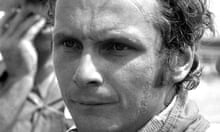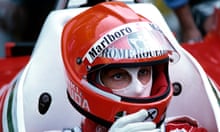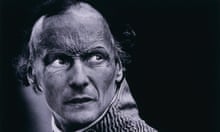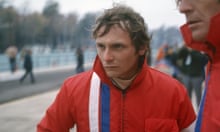Niki Lauda and I raced both alongside and against one another and remained friends until his death. His qualities, abilities and achievements are rightly admired, as were the clarity of his thinking and pragmatism. He was an intelligent man, a street-fighter, a three-times world champion and his comeback after the accident at the Nürburgring stands as the most courageous act I’ve seen any sportsperson ever make.
We met in the Formula Two championship in 1971, when Niki had joined the March team. He had the famous Niki Lauda hat – a baseball cap with the name of the bank on it – and rocked up in a Porsche 911-S with a stunning girlfriend, immediately making his mark.
What became evident quickly was that Niki was a very quick driver and he also had a very good understanding of how to set up a car and, most importantly, how to communicate that to the engineering side of the team. On top of which he got the drive by securing his own sponsorship in Austria. He had the capacity to find the funding to get into the position to display his talent and ability to move upwards.
This soon began to shine through and the consequence of that was being invited to join Ferrari in 1974 and taking the world title a year later. It was almost as if he had mapped it all out and he knew the phases he had to go through to get to where he wanted to be.
In 1976 at the Nürburgring I arrived just after the accident. Niki was out of the cockpit and close to the scene where the Ferrari was still smouldering, so we walked him away from that and laid him down and I knelt down and put his head in my lap so I could see his face. He was lucid and talking – my concern was to keep him stable and keep him talking.
What we didn’t realise at that point was that the burns, as severe as they were, were not life‑threatening, but the toxic fumes and superheated air he had inhaled when he was in the car were and he had done severe damage to his lungs.
Typically, he would not give in. He later said he couldn’t do anything to his body but he had a brain and used that to tell himself: “Let’s get up and get out of here.”
He did. Incredibly making it back to compete at Monza, having missed only two races. Getting over the physical injury was one thing, but the bigger problem was getting over the mental injury. Going through the process of stepping back into a race car and a grand prix was a huge achievement and more so when Ferrari were beginning to question whether he had what it takes to continue racing. Niki’s head was swathed in bandages; he had to use a bigger helmet so he could get it on and he was still bleeding.

Even going through the recovery his focus remained. Speaking to Niki in 1976, he was delighted with my victory in Austria because it had stopped James Hunt from winning another race.
We shared a team for the first time in 1978 at Brabham and he showed just what a driver needs to ensure he is in the best position to get the best from the equipment. Niki had honed his talents. His ability as a racing driver was only one of the qualities that enabled him to win world championships.
TimelineNiki Lauda's career
Show
Andreas Nikolaus Lauda is born in Vienna, Austria
Makes his Formula One debut for March-Ford in his home Austrian Grand Prix
Now driving for Ferrari, Lauda wins a Formula One race for the first time at the Spanish Grand Prix
Lauda secures his first world title for Ferrari at the Italian Grand Prix, with one race in the season left to go
Lauda is burned in a crash on the second lap of the German Grand Prix at the Nürburgring. His injuries are so severe that he is read the last rites, but remarkably, after reconstructive surgery on his face, he returns to racing the same season, only missing two races
Lauda takes his second world championship, securing victory with a fourth place finish in the US Grand Prix, with two races to go
Founds his first airline - Lauda Air
Having left Ferrari for Brabham, Lauda retires from Formula One at the end of the season
Lauda returns to the sport, this time driving for McLaren
Lauda finishes second behind Alain Prost in the final race of the season, but it is enough to give him a narrow half-point victory overall, and he secures his third world title
Wins his 25th Formula One race at the Netherlands Grand Prix
Retires from Formula One after competing in the Australia Grand Prix, with an overall record of 3 world championships, 25 wins and 54 podium finishes
Returns to Formula One in a consultancy role for Ferrari
Takes on the role of team principal of the Jaguar Formula One team
Lauda makes another airline venture, low-cost operator Niki. Lauda is sometimes in the cockpit himself
Becomes non-executive chairman of the Mercedes team, where he helped bring Lewis Hamilton to the team
Lauda dies peacefully, eight months after receiving a lung transplant
Niki changed perceptions, too. Mine, that motor racing was about two athletes, man versus man. But what marks out certain people in all aspects of life is that it’s not just about core ability, but also a range of qualities and that’s what Niki brought. His ability to communicate, his incisiveness in describing things, in being technically alert and aware of what would make a car work.
He was great company, too, a fun guy. When we went out for dinner with Bernie Ecclestone at Brabham, Niki used to laugh a lot. He had a great sense of humour and he was the most indiscreet man I’ve known – you could never tell him a secret.
We drove together again at McLaren in 1982 and 1983, a case of deja vu and he went on to take his third championship there in 1984. His first title at Ferrari in 1975 had been an important landmark, but you don’t win three by being lucky, – those that win multiple titles, well, there is a reason for that.
I don’t attend too many grands prix any more, but when I was at one, I would always meet with Niki and have a coffee. He liked his coffee – and his whisky – and we would chat, always the same patter, but so enjoyable because I liked him a lot and he liked me. Motor racing will miss him and so will I.
John Watson drove in Formula One from 1973-1985





